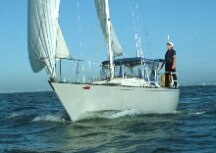The old time advice for a boat was to buy something heavy because the ride would be more comfortable. I was crossing to Hawaii with a friend who had a Rafiki 37 - a heavy displacement double ender with green marble countertops and a curved dinette - his wife loved them. As Hurricane Alma swept towards us, I sailed close-hauled North towards colder water. After two days I was far enough away from the hurricane center that I only experienced moderate winds and 12 foot swells. My friend couldn’t get his marble sinked double ender to sail close hauled in that wind. He was swamped by a breaking wave over the stern that tore the clothes off his back and would have drowned him if he hadn’t clung to the Edson rail at the wheel.
My boat sails to windward through rough weather. It responds to the swells like a duck - it goes over the waves not through them.







